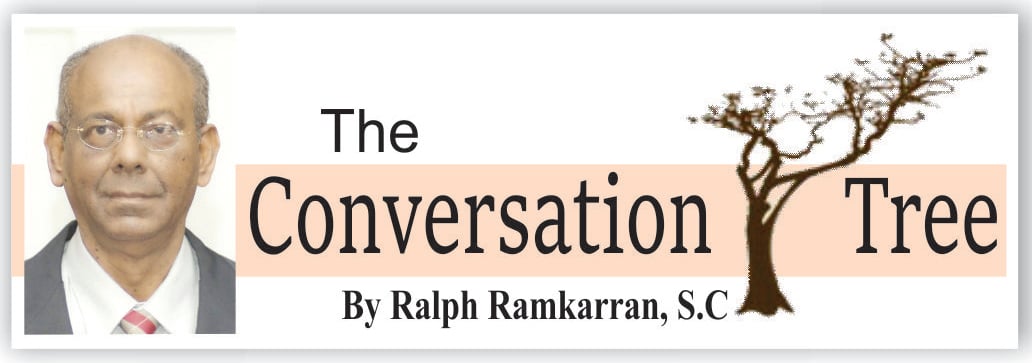The answer to the question posed in the above headline is that the PNCR is not going to wither away, despite the spate of recent resignations, the departure of the WPA from APNU and the slow death of the AFC. Neither is it going to be helped by the comical addition of two ‘new’ one-person political parties formed by Jaipaul Sharma and Tabitha Sarabo-Halley and welcomed to APNU with a straight face by President Granger.
Back in the day, we argued that political parties represented class interests and that the primacy of class over race should inform our hopes for a democratic outcome of Guyana’s authoritarian political dilemma. In fact, Eric Hobsbawm, the noted British historian, has remarked that that one of the fundamental conclusions of Marx’s output is the recognition of the necessity of separate political organisation to represent the interests of labour (’How To Change The World’). For a moment in the latter half of 1970s in Guyana, the unity of the bauxite and sugar workers in a common struggle against oppressive economic and political conditions, underlined by the growing collaboration between the PPP and the WPA, appeared to subsume the certainties of ethnic cleavage.
Unfortunately, the WPA’s mistaken assessment that a revolutionary situation had evolved in Guyana by the late 1970s, and its deployment of activities on that basis led to setbacks. The resulting disruption of united activities eventually led to a reversion to the dominance of the ethnic factor. Marx is not dead, as the scramble for his works during the 2008 financial crisis demonstrated, and which the most important work on economics in the past few decades, Thomas Piketty’s “Capital in the Twenty-First Century,” could not bring itself to pronounce, but he is at rest while political turbulence over time determines the relative importance of race or class. Clearly in Guyana, ethnicity will always dominate. But class unity, as in the 1950s PPP, or the late 1970s, can swiftly and dramatically alter perspectives.
The winning of the primary for the Democratic Party for mayor of Buffalo, New York, within the past few days, and political victories in the US over the past few years by progressive candidates, demonstrate that in ethnically charged communities, commonality of class interests can outweigh sharp ethnic divides. But not all societies are the same and not all are easily given to ethnic coalition building.
The Guyana experience of the latter half of the 1970s could have seen a resurgence in the latter half of the 2000s if the APNU+AFC coalition had implemented its manifesto promise for shared governance. The new structure proposed that the second largest party would nominate the prime minister, each party obtaining more than 30 percent of the vote being invited to join the government and all parties would share proportionately in ministries. It was believed that the PNCR had overcome its rejection of playing second fiddle which had caused it to reject the PPP’s proposals for a National Patriotic Front and the WPA’s proposal for Government of National Unity and Reconstruction in 1977, which were based on free and fair elections.
Had the manifesto proposals been implemented, it would have led to a large-scale identification of class interests, without antagonizing any other class, as we are now in the era of market economics and the private sector as the growth engine. Controversies such as about the Production Sharing Agreement between Guyana and Exxon, and about other investment agreements, would have been resolved in Guyana’s interests. But ethnic domination, never far from the surface in Guyana, took hold and, as in the 1970s, the PNCR in the form of APNU, gave Moses Nagamootoo the constitutional reform/power sharing mandate in a basket geared to fetch water, which he did with creative excuses.
The PNCR is in a dilemma. Its attempt to rig the elections has cost it the modest integrity it built up during Granger’s term of office. Then, his clumsy effort to sideline prominent leaders in order to promote Joe Harmon, has created severe stresses. Harmon’s floundering and aimless leadership, based on little else than hostility to the PPP/C Government, race baiting, ridiculous complaints about who signed the authentication letter for the Sputnik V vaccine, attacks on the vaccine programme and delivering flood relief, which the PNCR joined in in 2005, have not improved the standing of the PNCR. It is understood that a Party Congress cannot now be held. But David Granger’s silence over his own position is creating its own uncertainties.
The PNCR is not going to fade away. But a visionary leadership would abandon the quest for winning elections. It is the AFC which helped it in 2015. There would be no AFC on the scene again. The PNCR needs to come to terms to the fact that only a miracle will see it holding political office again, except in coalition with the PPP/C. In order to dig itself out of the rut in which it has found itself, it needs to resolve its leadership issue, develop a body of policies, based on a political solution in Guyana that will give aid in restoring its respectability. If not, its young leadership and potential leadership will continue to respond to the beckoning of the ‘good life’ from the petroleum economy.
This column is reproduced, with permission, from Ralph Ramkarran’s blog, www.conversationtree.gy






